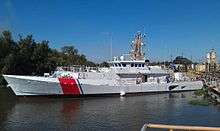USCGC Richard Etheridge (WPC-1102)
 Pre-commissioning photo of the future USCGC Richard Etheridge, moving to another mooring as her final equipment is added. | |
| History | |
|---|---|
| Name: | USCGC Richard Etheridge (WPC-1102) |
| Namesake: | Richard Etheridge |
| Operator: | United States Coast Guard |
| Builder: | Bollinger Shipyards, Lockport, Louisiana |
| Launched: | August 18, 2011 |
| Acquired: | May 26, 2012[1] |
| Commissioned: | August 3, 2012[2] |
| Status: | in active service |
| General characteristics | |
| Class and type: | Sentinel-class cutter |
| Displacement: | 353 long tons (359 t) |
| Length: | 46.8 m (154 ft) |
| Beam: | 8.11 m (26.6 ft) |
| Depth: | 2.9 m (9.5 ft) |
| Propulsion: |
|
| Speed: | 28 knots (52 km/h; 32 mph) |
| Endurance: |
|
| Boats & landing craft carried: | 1 × Short Range Prosecutor RHIB |
| Complement: | 2 officers, 20 crew |
| Sensors and processing systems: | L-3 C4ISR suite |
| Armament: |
|

The USCGC Richard Etheridge is the second of the United States Coast Guard's Sentinel-class cutters. Like most of her sister ships she will replace a 110 feet (34 m) Island-class patrol boat.
The Richard Etheridge was launched in August 2011.[3]
The vessel was officially delivered to the Coast Guard on May 26, 2012, at Key West, Florida,[1] and was commissioned into service in Port Everglades, Florida, on August 3, 2012.[2][4]
The Richard Etheridge, and the first and third vessels in the class, the Bernard C. Webber, and the William Flores, will all be based in Miami, Florida.[5]
Like the other ships of her class the Richard Etheridge is named after a heroic enlisted member of the Coast Guard.
Operational history
On March 18, 2014, the Richard Etheridge landed 1500 pounds of illicit drugs captured as part of Operation Martillo.[6]
Namesake Richard Etheridge
The Etheridge is named after Coast Guard hero Richard Etheridge, the first African-American to command a life-saving station. Etheridge led the Pea Island Lifesaving Station crew of six in a daring rescue operation that saved the entire crew of the schooner E.S. Newman, which had become grounded in a treacherous storm in 1896.
Design
The Sentinel-class cutters were designed to replace the shorter 110 feet (34 m) Island-class patrol boats.[7] Richard Etheridge is with a remote-control 25 mm Bushmaster autocannon and four, crew-served M2HB .50-caliber machine guns. It has a bow thruster for maneuvering in crowded anchorages and channels. It also has small underwater fins for coping with the rolling and pitching caused by large waves. It are equipped with a stern launching ramp, like the Marine Protector-class and the eight failed expanded Island-class cutters. It has a complement of twenty-two crew members. Like the Marine Protector class, and the cancelled extended Island-class cutters, the Sentinel-class cutters deploy the Short Range Prosecutor Rigid-hulled inflatable (SRP or RHIB) in rescues and interceptions.[8] According to Marine Log, modifications to the Coast Guard vessels from the Stan 4708 design include an increase in speed from 23 to 28 knots (43 to 52 km/h; 26 to 32 mph), fixed-pitch rather than variable-pitch propellers, stern launch capability, and watertight bulkheads.[9]
Richard Etheridge has an overall length of 153 feet 6 inches (46.79 m), a beam of 25 feet (7.6 m), and a displacement of 325 long tons (330 t; 364 short tons). Its draft is 9 feet 6 inches (2.90 m) and it has a maximum speed of over 28 knots (52 km/h; 32 mph). The Sentinel-class cutters have endurances of five days and a range of 2,950 nautical miles (3,390 mi; 5,460 km).[7]
References
- 1 2 "Second Fast Response Cutter Delivered to the Coast Guard" (Press release). United States Coast Guard. 2012-05-30. Retrieved 2012-05-30.
- 1 2 "Coast Guard commissions 2nd Fast Response Cutter at Port Everglades". Coast Guard News. 2012-08-03. Retrieved 2012-08-03.
- ↑ "Bollinger Built Fast Response Cutter Undergoes Sea Trials". Maritime Executive. 2011-12-06. Retrieved 2011-12-13.
The vessel, now known as BERNARD C. WEBBER, was launched on April 21 and first got underway on November 27th to begin builder’s trials. The builder’s trials will include pier side and underway machinery and equipment tests including propulsion, command control and navigation. After successful builder’s trials WEBBER will prepare for acceptance trails by the Coast Guard, prior to its January 2012 delivery.
mirror - ↑ Rhonda Carpenter (2012-11-05). "Coast Guard Commissions Third Fast Response Cutter, William Flores". Defense Media Network. Archived from the original on 2013-01-04.
The first six FRCs for District 7 will be homeported in Miami; the next six in Key West; and the remaining six in Puerto Rico.
- ↑ "Acquisition Update: Second Sentinel-class Fast Response Cutter Contract Option Awarded". United States Coast Guard. 2010-09-15. Retrieved 2011-12-13.
- ↑ "Coast Guard Seizes Cocaine and Marijuana". Maritime Executive. 2014-03-18. Retrieved 2014-03-19.
Crewmembers aboard the Coast Guard Cutter Richard Etheridge, a 154-foot Sentinel-class Fast Response Cutter homeported at Sector Miami, offload approximately 1,500 pounds of cocaine, worth an estimated wholesale value of $23 million, in St. Petersburg, Fla., Monday, March 17, 2014.
- 1 2 "Fast Response Cutter" (PDF). United States Coast Guard. Retrieved 24 August 2015.
- ↑ "Short Range Prosecutor (SRP)". Integrated Deepwater System Program. Retrieved 2007-09-01.
- ↑ "Bollinger awarded potential $1.5 billion FRC contract". Marine Log. 2009-09-26. Archived from the original on 2009-10-10.
| Wikimedia Commons has media related to USCGC Richard Etheridge (WPC 1102). |